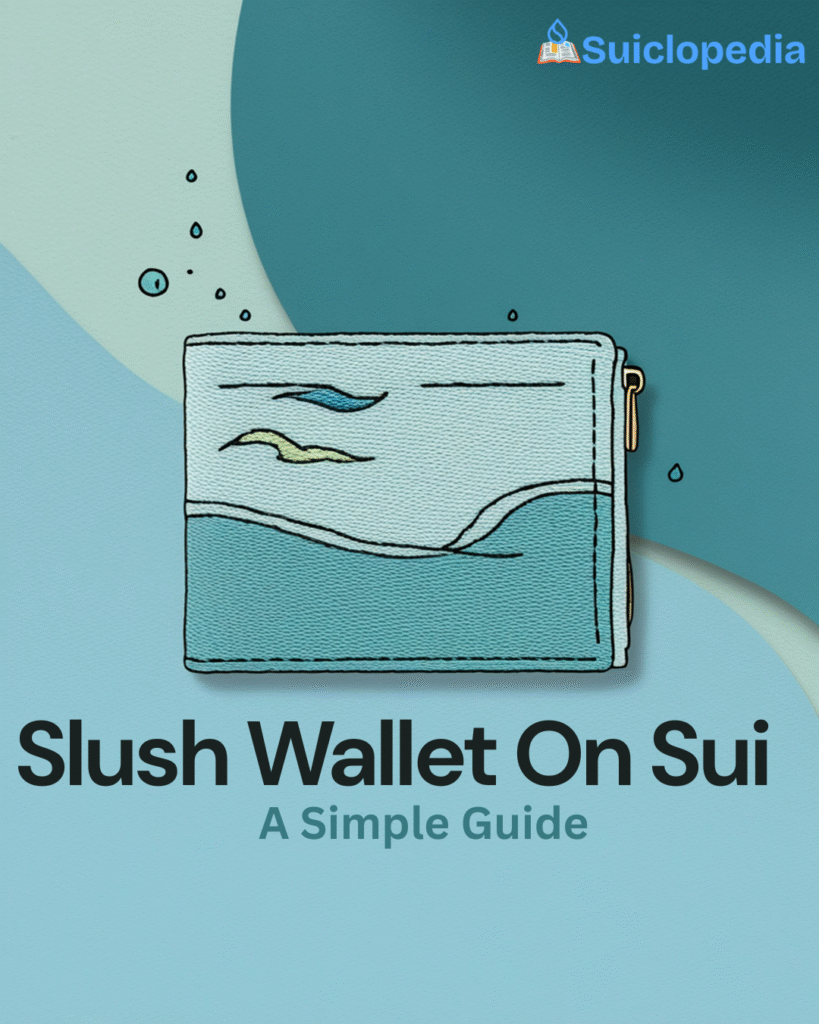The Walrus Protocol is one of the most important innovations on the Sui blockchain. It provides a way to store, access, and share data securely without needing to rely on any centralized server. You can think of it as a decentralized version of Amazon Web Services (AWS), built specifically for the needs of Web3 apps, NFTs, and AI tools.
In this article, we will break down everything you need to know about the Walrus Protocol. We’ll cover what it is, how it works, its main features, the WAL token, and how it fits into the future of blockchain technology. If you’re curious about how Sui handles data or what makes Walrus so special, this guide is for you.
What Is the Walrus Protocol?
The Walrus Protocol is a decentralized storage solution built on top of the Sui blockchain. It gives developers and users a way to store both public and private data in a secure, verifiable, and scalable way.
Traditional apps store data on centralized servers like AWS or Google Cloud. But in Web3, those centralized services go against the goals of privacy, censorship-resistance, and transparency. That’s where Walrus comes in.
With Walrus, you can store text files, images, metadata for NFTs, smart contract logs, AI model outputs, and personal encrypted files – all in a trustless, decentralized way.
The name might sound funny at first. But it fits within the ocean theme of the Sui ecosystem, where many tools and protocols are named after sea creatures, like Mysticeti (Sui’s consensus mechanism), seal, nautilus, mist, pilotfish and Remora. The walrus represents strength, reliability, and resilience. It is built to handle large works and survive in tough environments, just like this protocol.
Key Features of Walrus Protocol
Let’s explore the main features that make Walrus stand out:
1.
Decentralized Data Storage
Walrus stores data across a network of nodes instead of keeping it in one place. This removes single points of failure and makes it nearly impossible for your data to be lost or censored.
2.
On-Chain + Off-Chain Storage
Some data can be stored directly on the Sui blockchain (on-chain), while larger files are stored off-chain but still verifiable through Sui’s consensus system. Walrus bridges the two, making sure all data remains trustworthy.
3.
Data Versioning and Immutability
Every piece of data on Walrus is versioned. This means you can track every change, rollback to previous versions, and ensure that old data isn’t secretly overwritten.
4.
Access Control
You can set rules about who can see or modify certain data. This is especially helpful for encrypted content or sensitive project data. It’s like setting private folders inside a decentralized network.
5.
End-to-End Encryption
All private data stored through Walrus can be encrypted. Only people with the right keys can read it, not even the storage nodes. This keeps your data safe.
6.
Content-Addressing
Each file or object is stored using its cryptographic hash as an identifier. This means the content can be verified without relying on external metadata. If the data changes, the hash changes, keeping everything secure and tamper-proof.
7.
Low-Cost & Scalable
Because of Sui’s performance and low fees, Walrus can store and retrieve large amounts of data at a fraction of the cost of other chains or services like IPFS.
8.
AI and NFT Compatibility
Walrus is designed for modern Web3 use cases. That includes AI tools that generate data on the fly, and NFT projects that need secure metadata and ownership logs. The protocol is also powering the next generation of Sui-native apps.
The WAL Token Explained
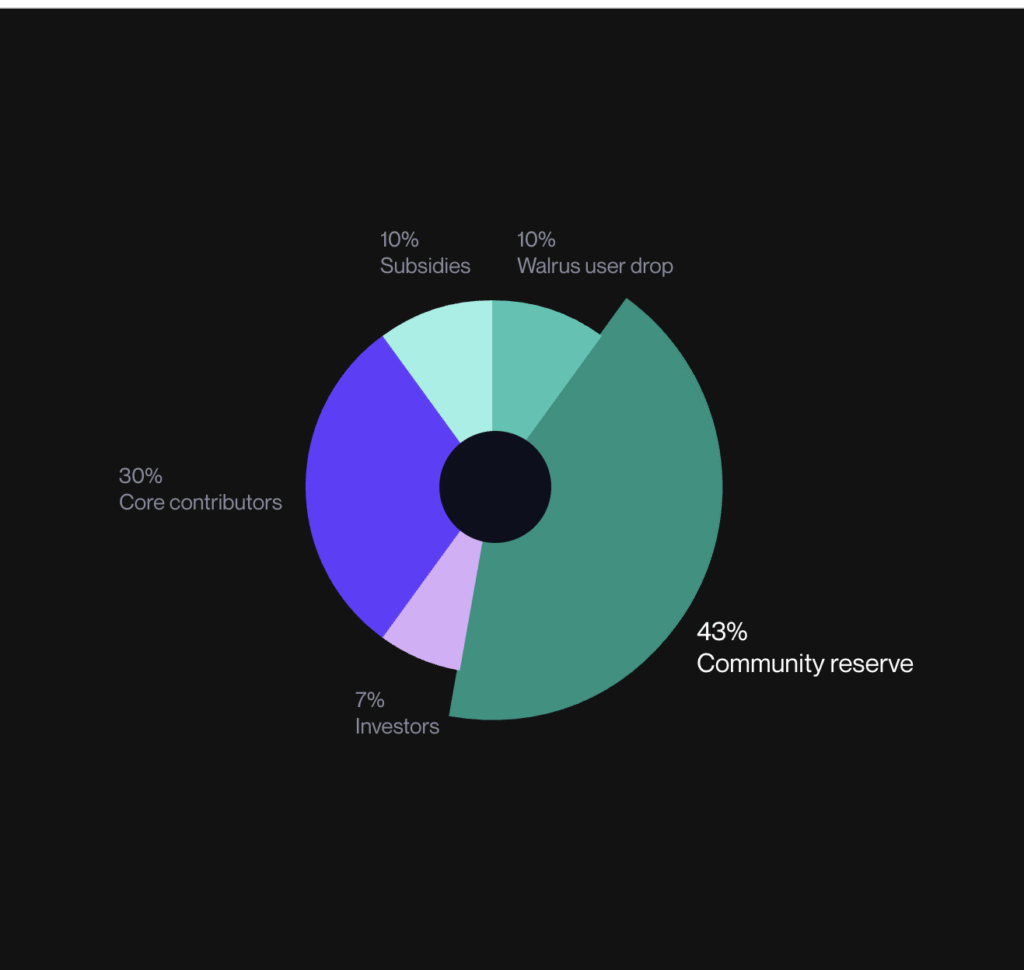
The Walrus Protocol has its own native token: WAL. It launched on March 27, 2025, and plays a central role in how the protocol works and grows. WAL is not just a governance or reward token; it is a utility token that fuels the storage network.
What WAL is Used For:
- Storage payments: Developers pay WAL to store and retrieve data.
- Node rewards: Operators who contribute to the network by storing and serving data are rewarded in WAL.
- Staking: Users can stake WAL to support the protocol’s security and earn rewards.
- Governance: WAL holders can vote on protocol upgrades and fee structures.
Tokenomics
The full breakdown of WAL’s supply and token distribution is available on walrus.xyz, but here are the basics:
- Fixed max supply (5,000,000,000 tokens)
- Deflationary mechanics (staking penalty fees will be burnt).
- Community-focused distribution (over 60% is allocated to the community).
- Incentives for long-term stakers and developers (stakers are in line to win future airdrops)
Through these mechanics, WAL helps make the Walrus Protocol sustainable and decentralized.
Introducing Quilt – Walrus’s Smart Storage Upgrade
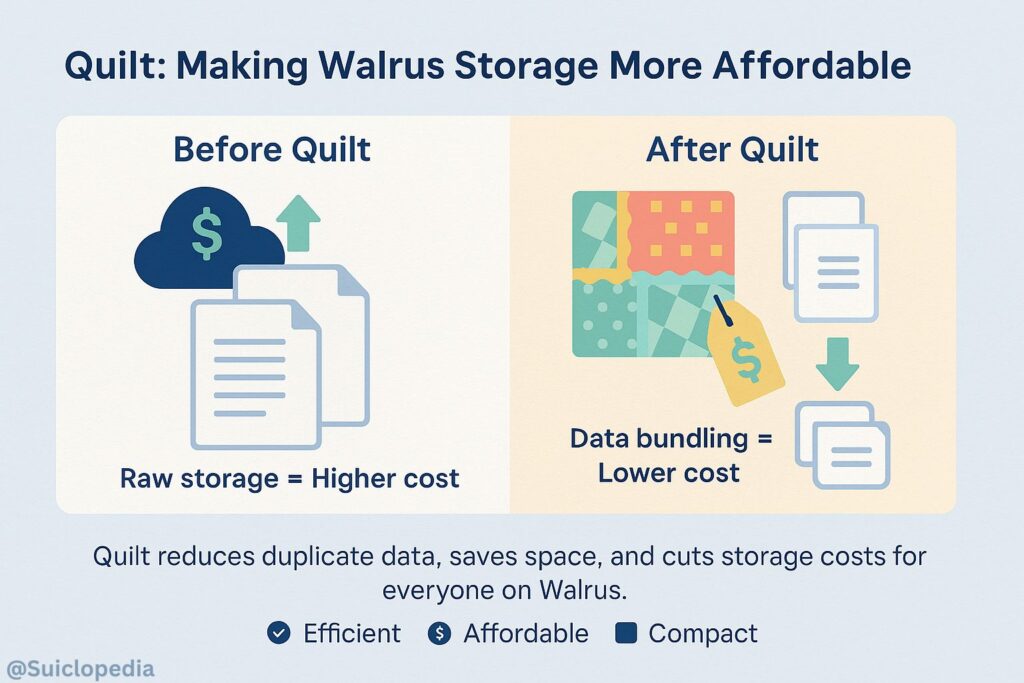
On July 23, 2025, Walrus launched a major upgrade called Quilt. This upgrade is a game-changer, especially for apps that need to handle lots of small files.
What Problem Does Quilt Solve?
Before Quilt, every small file (like a chat message or a log entry) had to be stored separately on-chain. That meant high gas fees and extra overhead. Developers tried to bundle files manually, but it was clunky and slow. Quilt was created to solve this by bundling small files automatically into bigger groups called “Quilts.”
How It Works
- Quilt takes dozens to hundreds of tiny files (up to ~ 660) and combines them into one big container.
- It handles all the work. Developers do not need to manually package files.
- You can still retrieve each file individually when you need it.
Why It Matters
This makes storing small files up to 420× cheaper. For example:
- A 10 KB blob is now 420× cheaper to store.
- A 100 KB blob sees 106× savings.
- Even gas fees on Sui (which are already cheap) have become cheaper for data operations
That’s a massive reduction in cost for developers running games, chat apps, and real-time systems on Sui.
Quilt’s Bonus Features:
- Clean API that’s easy to use
- Organized metadata, file tagging, and indexing
- Efficient on-chain logic for managing bundles
Real-World Use Cases Of Walrus Protocol
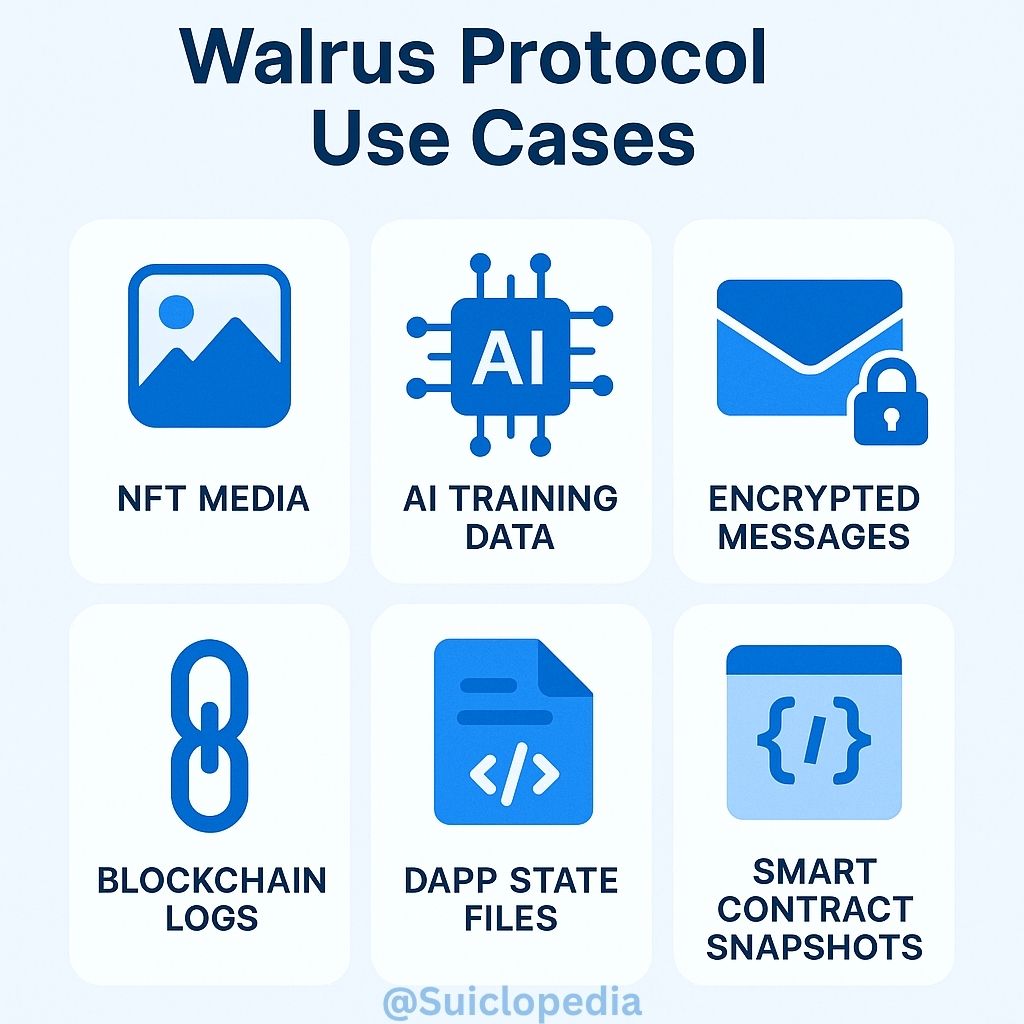
1.
NFT Metadata Storage
Projects can store all NFT data (art, metadata, traits) directly on Walrus, reducing dependency on third-party links or centralized servers.
2.
Decentralized AI Platforms
AI projects that run on-chain can use Walrus to store training data, results, and prompts. Everything remains transparent, auditable, and secure.
3.
Private File Storage
Users or apps can save encrypted documents on Walrus. Only the owner or whitelisted accounts can decrypt them.
4.
Web3 Social Platforms
Messages, posts, and content can be stored permanently and censorship-free.
5.
Smart Contract Logs
Protocols can push logs of their transactions or system updates to Walrus for transparency.
How to Use Walrus
You can interact with Walrus through:
- The Walrus dApp: A visual interface for uploading, encrypting, and managing your files
- Developer SDKs: Walrus offers tools for developers to integrate it into Sui dApps
- Smart contracts: Move modules on Sui can call Walrus functions
A simple user flow might look like this:
- Upload a file to Walrus
- Choose whether it’s public or private
- Receive a content-addressable hash
- Pay a small WAL fee
- File is now stored and accessible via Sui-compatible apps
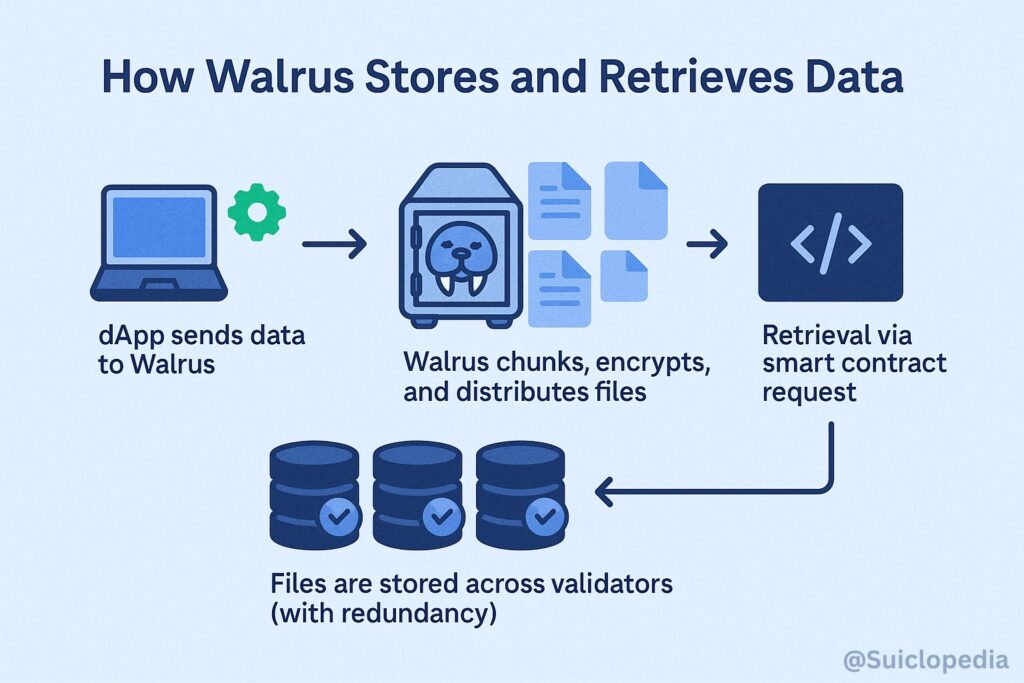
Comparison to Other Protocols
Walrus is often compared to:
| Protocol | Chain | Strengths |
| IPFS | Multi | Popular, flexible, but slower and harder to secure |
| Arweave | Solana, Others | Great for permanent storage but expensive |
| Filecoin | Multi | Large storage economy but complex setup |
| Walrus | Sui | Fast, cheap, Web3-native, supports private storage, built for AI & NFTs |
The main advantage of Walrus is its deep integration into the Sui ecosystem, its support for modern use cases, and its balance between cost, speed, and security.
The Vision for the Future
The Walrus team has shared that their long-term goal is to create an unstoppable data layer for the internet, not just for crypto. In the future, we could see Walrus powering web3 gaming assets, AI-generated world data, decentralized media platforms, personal cloud storage, and entire decentralized applications.
The WAL token will continue to play a central role in coordinating this decentralized infrastructure.
Final Thoughts
The Walrus Protocol is a foundational layer for Web3 apps on Sui. It solves real data problems like security and privacy. With features like encryption, AI compatibility, and low fees, it’s helping Sui become the next layer of the internet.
Whether you’re a developer, NFT creator, AI builder, or just curious about Sui’s growth, Walrus is a project worth watching. You don’t have to understand all the technical details. Just know this that Walrus is positioning itself as the only way to do much more with your data.

